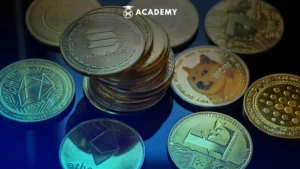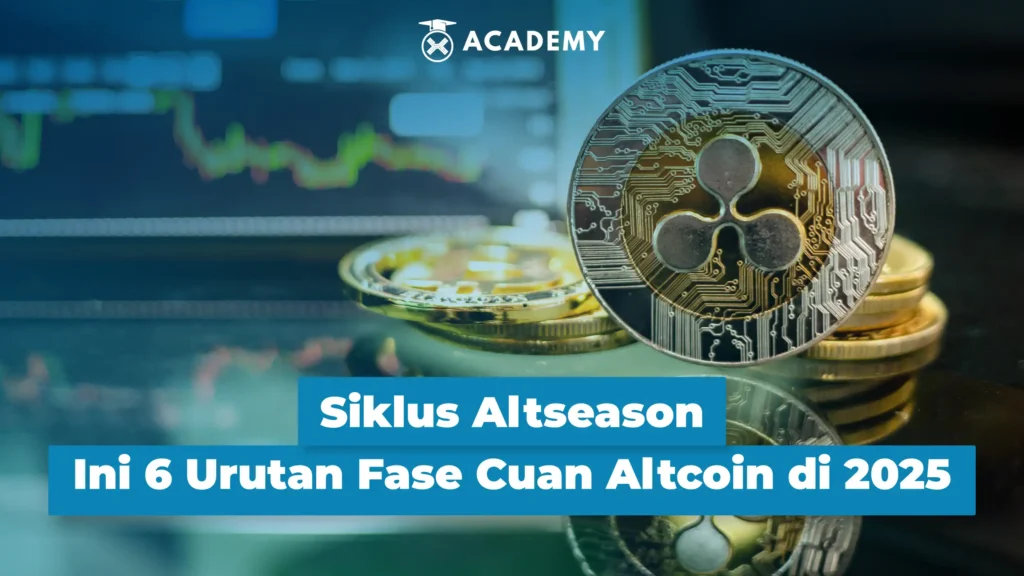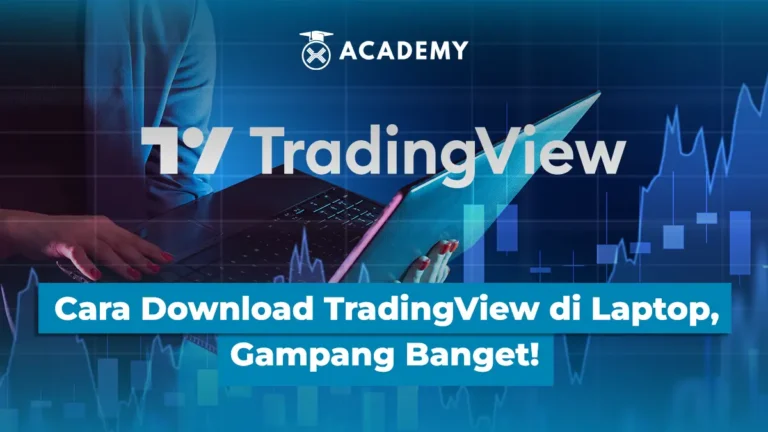Many new investors are tempted to enter altseason when everything is already high, when FOMO is at its peak.
During this phase, the risk of a major correction can occur at any time. Ironically, the golden moment at the start of altseason is often missed.
However, if you understand the cycle pattern, you can know when the right time to enter and when to exit before euphoria turns to regret.
So, to better understand the altseason cycle, let’s take a look at the full explanation below.
Why Does Altseason Have a Cycle?

Altseason doesn’t emerge suddenly, but is triggered by three main factors: money flow rotation, market psychology, and macroeconomic conditions and developments in the crypto ecosystem.
Broadly speaking, altseason occurs when investors begin to slowly shift their capital from one type of asset to another. This shift generally begins with Bitcoin, given its position as the most stable and dominant crypto asset.
After Bitcoin’s price increases and stabilizes, investors begin to look to large-cap altcoins like Ethereum for higher returns.
As the market heats up, funds begin to flow into small-cap altcoins, which are high-risk but offer the potential for sharp gains. This is why altseason often occurs after Bitcoin’s rally slows.
However, this capital rotation is also influenced by the market’s emotional cycle. It typically begins with a fear phase when prices stagnate and investors hesitate, then turns to greed when prices start to rise and look promising.
Furthermore, the FOMO (fear of missing out) phase emerges, prompting many to enter without a well-developed strategy, and finally, a euphoria phase occurs when the majority of market participants believe prices will continue to rise.
At its peak, the market enters a distribution phase, where existing investors slowly begin selling, signaling a potential price decline.
Furthermore, macroeconomic factors also play a role. Events like the Bitcoin halving, which reduces the supply of BTC every four years, often trigger a rise in Bitcoin prices, which then pushes altcoins higher.
Furthermore, when global conditions are favorable, such as low interest rates or economic stimulus, funds are more readily drawn to riskier assets like crypto.
If this situation coincides with a decline in Bitcoin dominance, the chance of an alt season increases.
Altseason Cycle Phase Sequence (Visual-narrative)
The altseason cycle doesn’t happen suddenly. It develops gradually, following patterns of fund flows and market sentiment that intensify over time. The following is a typical sequence of phases:
Phase 1: Bitcoin Rises First
Altseason usually begins with a Bitcoin rally. When BTC shows sharp gains, many institutional and retail investors begin to enter the market.
As the most established crypto asset, Bitcoin is a safe place to park large amounts of capital at the start of an uptrend. This surge signals the beginning of a rotation of money that will flow into other assets.
2. Phase 2: Ethereum Outperforms
After Bitcoin’s price rises significantly and begins to consolidate, attention shifts to Ethereum. ETH often outperforms BTC during this phase, as investors seek assets with greater upside potential while maintaining a strong reputation.
When ETH outperforms, investors begin to seek out similar projects with mid-market caps that also have Layer-1 ecosystems or smart contract use cases. This momentum triggers the initial broader movement into altcoins.
Phase 3: Layer-1 & Bluechip Altcoins Join the Rally
Seeing Ethereum lead the market, investors began to spread capital to other Layer-1 projects like Solana, Avalanche, or Near. Furthermore, altcoins with solid reputations like Chainlink, Cosmos, and Polygon began to gain traction.
This shift marked the widening of the altseason cycle, where money began to flow out of the major players and into assets perceived as having strong technology and real adoption. Risks increased, but the potential for profit was also greater.
Phase 4: Mid/Low Cap Altcoins Explode
As major projects gained momentum, investors began to hunger for more extreme surges. This is where mid- and low-cap altcoins began to be sought after. Many of these projects were not yet widely known but had strong narratives or active communities.
The transition from major altcoins to smaller altcoins occurred as investors felt left behind and began searching for the “next Solana” or “next big thing.” FOMO began to grow rapidly, and price spikes could be quite sharp in a short period of time.
Phase 5: Meme Coin Boom (Peak Euphoria)
The peak of altseason is marked by the explosion of meme coins like DOGE, SHIBA, PEPE, and the like. Prices rise crazily, not because of the technology, but because of the hype and fanatical community.
At this point, the market is already highly euphoric. Newcomers enter simply out of fear of missing out, not because of analysis. Many of them don’t even understand how crypto fundamentals work. This is a sign that the market has become overheated.
Phase 6: Exit to Stablecoins
After the euphoria reaches its peak, more experienced investors begin to slowly exit. They shift their funds to stablecoins like USDT or USDC to secure profits. Volume begins to decline and prices begin to correct.
In this phase, smaller projects begin to abandon them. Altcoins stagnate or plummet, and many retail investors end up stuck. The cycle ends, returning to the accumulation phase.
How to Check the Altseason Cycle: Real-Time Data Indicators
Altseasons do have patterns that can be studied, but to know whether we’re at the beginning, middle, or end of the cycle, you need to observe real-time data.
Fortunately, there are a number of indicators that can help you read market conditions objectively, rather than just following the hype.
One early sign of an altseason is when Bitcoin dominance (BTC Dominance) begins to decline. This means Bitcoin’s market capitalization is shrinking, indicating that funds are shifting to altcoins. This data can be monitored via TradingView or CoinGlass.
The next important indicator is the ETH/BTC ratio. If the chart rises, it means Ethereum is outperforming Bitcoin, which usually signals that other altcoins will follow. ETH often leads the way before an altseason expands.
After ETH takes the lead, pay attention to the altcoin’s trading volume. If its volume proportion to the market increases, it indicates that investors are starting to rotate funds to other projects perceived as having greater potential.
You can also look at external signals such as Google Trends. A surge in searches for keywords like “altcoin” or “buy crypto” reflects increased public interest, especially retail investors who typically enter when a trend strengthens.
An additional indicator is the altcoin total market cap chart. If its value rises sharply and consistently, it’s strong evidence that altseason is underway and funds are starting to spread to assets beyond Bitcoin.
All of these metrics can be monitored through platforms like CoinGlass, TradingView, or CoinMarketCap. By regularly monitoring these indicators, you can make decisions based on real signals, not just hunches.
Phase-Based Entry and Exit Strategy
Success during altseason isn’t just about choosing the right asset; it’s also about when to enter and exit.
Timing is everything, so a cycle-based strategy is crucial for maintaining sound risk management amidst volatile markets.
An effective initial step is to enter when Ethereum begins to break out of its consolidation phase.
ETH often leads the movement, and when ETH/BTC begins to strengthen, it could be a signal that altseason is beginning. This is the ideal time to start entering gradually.
After that, pay attention to the altcoin market cap. If it starts to rise sharply, it means funds are flowing heavily into non-Bitcoin projects.
However, entering gradually is still much wiser than going all-in. Use a graduated approach to adjust to market conditions.
Conversely, when meme coins start to reach all-time highs, you need to be cautious. This phase often signals that market euphoria has reached its peak. At this point, many retail investors are tempted to jump on the bandwagon, even though the smart money has usually already started to exit.
For an exit strategy, the safest approach is to take profits in installments when mid-cap altcoins start to skyrocket and meme coins go viral. This helps you secure profits while still opening up opportunities if the market continues to rise.
From the start, it’s also recommended to diversify your portfolio across sectors. Don’t just focus on one type of asset.
Mix Layer-1s like Solana or Avalanche, altcoins with strong utility like Chainlink, and tokens that are rising due to narratives like AI, DePIN, or restaking. This diversification helps balance risk when the market moves unevenly.
Hidden Risks in Cycles
Altseason is indeed an attractive moment because it offers the potential for large profits in a relatively short time.
However, behind these opportunities, there are many pitfalls that are not always visible on the surface, especially for investors who are not accustomed to reading market dynamics holistically.
One common mistake is to assume altseason has begun simply because a few altcoins have risen sharply in a few days. However, this could simply be a short-term technical rebound, not the start of a long-term trend.
Entering too soon can trap you in a boring sideways phase, or even a fairly deep market correction.
Furthermore, there is also what is called a fake altseason, where Bitcoin dominance drops and altcoins appear to strengthen.
However, upon closer inspection, this decline in dominance is often caused by a sharp BTC price correction, not because altcoins are genuinely strengthening.
As a result, the altcoin’s upward movement is often short-lived, only to fall back down following the market’s currents.
Equally important, the risk of becoming liquidated is also worth noting. When the price of a small altcoin suddenly spikes drastically, it could be a deliberate scenario set up by large players to unwind their positions.
They create euphoria to entice retail investors to buy at a high price, then quietly sell.
As a result, small investors who entered at the height of the hype end up “buying high” from those who were already ready to exit.
Brief Case Study: Altseason 2021 & The 2025 Pattern

From April to May 2021, the altseason reached its peak. After Bitcoin broke its previous all-time high, the market shifted to Ethereum, which posted impressive performance, marking the second phase.
Shortly afterward, interest spread to layer-1 cryptocurrencies like BNB, SOL, and AVAX, marking the third phase.
The peak occurred when mid- and small-cap altcoins like DOGE, MATIC, and SHIBA surged sharply, marking the fourth phase, marked by market euphoria and a massive rally.
Comparatively, the third phase of that year was swift due to the surge in enthusiasm for “Ethereum killers” and DeFi. However, the fourth phase was even more frenetic, driven by viral narratives and the influx of retail investors.
As 2025 approached, some early signs began to emerge. ETH/BTC showed strong signs of consolidation, while altcoin volumes and searches for keywords like “buy altcoin” began to increase.
While not conclusive, this could signal that the next early phase of the altseason was taking shape.
Conclusion: Not Just a Season, But a Rotation Strategy
So, that was an interesting discussion about the Altseason Cycle: 6 Phases of Altcoin Profits in 2025, which you can read in full at the INDODAX Academy.
In conclusion, altseason isn’t just about peak altcoin buying, but rather about understanding recurring capital rotation patterns.
Anyone can join in the euphoria, but only investors who understand the sequence, from Bitcoin’s dominance to Ethereum’s movements to smaller altcoin spikes, can capitalize on opportunities consciously.
By recognizing this cycle, you not only have greater profit opportunities but also better risk protection. Because in a volatile market, strategy is more important than simply going with the flow.
By the way, besides broadening your investment horizons, you can also stay updated with the latest crypto news and monitor digital asset price movements directly on the INDODAX Market. For a more personalized trading experience, explore our OTC trading service at INDODAX. Don’t forget to activate notifications to stay up-to-date with the latest information about digital assets, blockchain technology, and various other trading opportunities, only at INDODAX Academy.
You can also follow our latest news on Google News for faster and more reliable access to information. For an easy and secure trading experience, download the best crypto app from INDODAX on the App Store or Google Play Store.
Maximize your crypto assets with the INDODAX Earn feature, a practical way to earn passive income from your holdings.
Also follow us on social media here: Instagram: Instagram, X, Youtube & Telegram
FAQ
1.What is the difference between a regular altseason and an altseason cycle?
The altseason cycle describes the gradual, structured rotation of funds from BTC to other altcoins.
2.Do all altcoins rise during an altseason?
Not always. Those that rise are usually those with a strong narrative, high volume, and a positive market trend.
3.When is the best time to enter an altcoin during an altseason?
Ideally, it’s when Ethereum starts to outperform Bitcoin and BTC dominance begins to decline.
4.How do you know the altseason is in its final phase?
If meme coins start to dominate and extreme volatility occurs, it could be the distribution phase (the final phase).
Author: Boy






 Polkadot 10.19%
Polkadot 10.19%
 BNB 2.15%
BNB 2.15%
 Solana 4.87%
Solana 4.87%
 Ethereum 2.37%
Ethereum 2.37%
 Cardano 1.64%
Cardano 1.64%
 Polygon Ecosystem Token 2.11%
Polygon Ecosystem Token 2.11%
 Tron 2.90%
Tron 2.90%
 Market
Market


